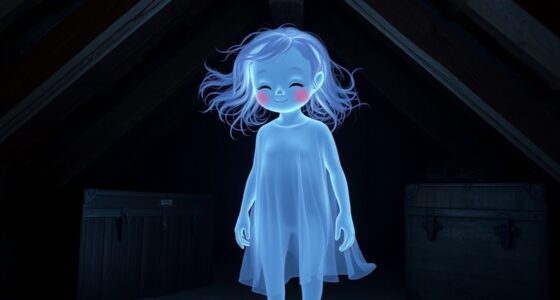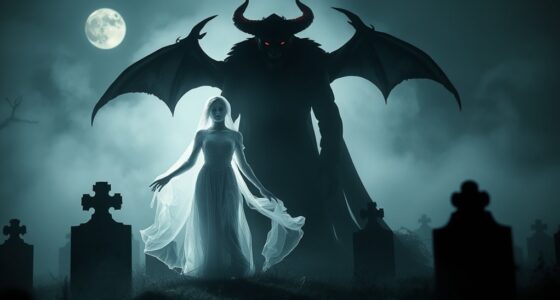Yes, there are modern individuals who identify as “real vampires” or sanguinarians. They actively seek out blood and energy to meet their unique needs, often experiencing symptoms related to this during puberty. While they lack supernatural powers, their practices stem from genuine requirements or medical conditions. These individuals challenge conventional ideas about humanity, creating a complex identity. Keep exploring to uncover more about the fascinating blend of myth, culture, and the real-life experiences of these self-identified vampires.
Key Takeaways
- Real vampires exist as modern individuals who identify with the lifestyle, including blood drinking and energy feeding, but lack supernatural abilities.
- An estimated 5,000 people in the U.S. identify as sanguinarians, often feeling a genuine need to consume blood or energy.
- Historical folklore and figures, like Vlad the Impaler, contributed to the vampire myth, blending fact with fiction over centuries.
- Modern portrayals in media often depict vampires as complex beings grappling with their humanity and identity, rather than purely malevolent creatures.
- The phenomenon of real vampires invites exploration of human experience, identity, and societal complexities surrounding their existence.

Have you ever wondered if vampires really exist? While traditional vampires, with their supernatural powers and immortality, belong to the domain of myth, there are individuals who identify as “real vampires.” These modern vampires often engage in activities related to drinking blood or energy feeding, particularly in places like New Orleans, where the culture embraces the mysterious and the unusual.
It’s fascinating to reflect on how the vampire myth has evolved over time and how it reflects our changing perceptions of humanity. In some cases, individuals drawn to this lifestyle may exhibit traits similar to those seen in borderline personality disorder, complicating their relationships and self-identity.
You might be surprised to learn that a 2015 survey estimated around 5,000 people in the U.S. identify as sanguinarians, individuals who feel a genuine need to consume blood for various reasons. Unlike the vampires we see in movies and books, these real vampires don’t possess supernatural abilities. Many of them face medical conditions that create a need for blood or energy from others, often experiencing symptoms as they go through puberty. This adds a different layer to the vampire narrative, showing that the line between myth and reality can be quite blurred.
The vampire myth has deep roots, with folklore dating back thousands of years. Historical figures like Vlad the Impaler helped shape the terrifying image we now associate with vampires, and literary works such as Bram Stoker’s “Dracula” solidified their place in popular culture.
Stoker’s novel introduced us to the archetype of the vampire, a seductive and dangerous figure that captured the imagination of many. Today, however, the portrayal of vampires has shifted. In modern popular culture, we often see them as more relatable characters, grappling with their identities and emotions, as showcased in series like “Twilight” and “True Blood.”
As you explore further into the world of vampires, it’s crucial to recognize that the fascination often stems from our desire to investigate the unknown. Whether it’s through blood-drinking or energy feeding, those who identify as real vampires seek a sense of belonging and community. Just as affairs can create emotional distress in relationships, the quest for identity among modern vampires illustrates the complexities of human experience.
They challenge our notions of what it means to be human, blurring the lines between the mythical and the real. So, while traditional vampires may not exist, the world of modern vampires offers a unique glimpse into the complexities of human experience, inviting you to ponder the nature of reality and the stories we tell ourselves.
Frequently Asked Questions
Are There Real Vampires?
Yes, there are individuals who identify as real vampires. You’ll find that some engage in practices like blood consumption, while others draw energy from those around them.
This community includes various types, such as sanguinarians and psychic vampires, each with unique needs. Many conceal their identities due to stigma, but they lead ordinary lives and often form supportive networks.
Understanding their experiences can help you see the diversity within this fascinating subculture.
Can a Human Become a Vampire?
Imagine standing in a dimly lit room, an ancient tome whispering secrets of transformation.
Can a human become a vampire? Well, not in the traditional sense. You won’t sprout fangs or gain immortality, but some individuals embrace the identity, adapting their lifestyle to include practices like energy feeding or blood consumption.
This journey often begins in adolescence, as you discover unique needs that set you apart from those around you.
The community awaits.
Who Is the First Real Vampire?
When you think about the “first real vampire,” many point to Vlad the Impaler. His brutal reign in the 15th century inspired countless tales of bloodthirsty creatures.
While he wasn’t a vampire in the mythological sense, his cruelty and the legends surrounding him laid the groundwork for the vampire lore that we understand today.
You can see how his life influenced writers like Bram Stoker, shaping the modern vampire image that we’re familiar with.
What Is the Vampire Disease in Real Life?
When it comes to the vampire disease in real life, you might think of porphyria, which is as real as the sun rises.
This medical condition affects your blood and liver, causing severe symptoms like sensitivity to sunlight and dark red urine. People with porphyria often avoid sunlight to escape painful reactions, fueling the myths of vampires.
While the folklore is fascinating, porphyria is a serious health issue that needs proper treatment.
Conclusion
So, is there really such a thing as a vampire? While the supernatural creatures of folklore might not exist, certain real-life cases, like the disorder known as porphyria—where individuals are sensitive to sunlight—spark curiosity. Imagine someone living in the shadows, avoiding daylight to protect their skin, resembling the very legends of vampires. These intriguing overlaps between reality and myth remind us that the line between fact and fiction can sometimes blur in fascinating ways.









